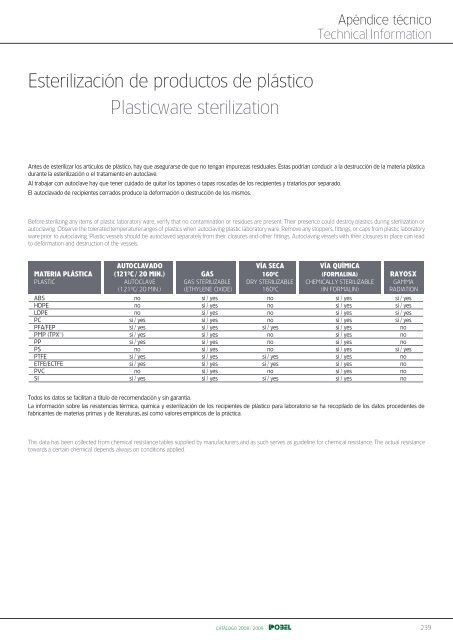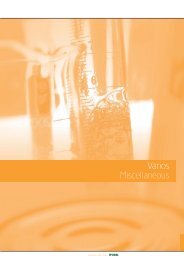Apéndice técnico - Material de laboratorio POBEL
Apéndice técnico - Material de laboratorio POBEL
Apéndice técnico - Material de laboratorio POBEL
Create successful ePaper yourself
Turn your PDF publications into a flip-book with our unique Google optimized e-Paper software.
Esterilización <strong>de</strong> productos <strong>de</strong> plástico<br />
Plasticware sterilization<br />
CATÁLOGO 2008 / 2009<br />
<strong>Apéndice</strong> <strong>técnico</strong><br />
Technical Information<br />
Antes <strong>de</strong> esterilizar los artículos <strong>de</strong> plástico, hay que asegurarse <strong>de</strong> que no tengan impurezas residuales. Éstas podrían conducir a la <strong>de</strong>strucción <strong>de</strong> la materia plástica<br />
durante la esterilización o el tratamiento en autoclave.<br />
Al trabajar con autoclave hay que tener cuidado <strong>de</strong> quitar los tapones o tapas roscadas <strong>de</strong> los recipientes y tratarlos por separado.<br />
El autoclavado <strong>de</strong> recipientes cerrados produce la <strong>de</strong>formación o <strong>de</strong>strucción <strong>de</strong> los mismos.<br />
Before sterilizing any items of plastic laboratory ware, verify that no contamination or residues are present. Their presence could <strong>de</strong>stroy plastics during sterilization or<br />
autoclaving. Observe the tolerated temperatureranges of plastics when autoclaving plastic laboratory ware. Remove any stoppers, fittings, or caps from plastic laboratory<br />
ware prior to autoclaving. Plastic vessels should be autoclaved separately from their closures and other fittings. Autoclaving vessels with their closures in place can lead<br />
to <strong>de</strong>formation and <strong>de</strong>struction of the vessels.<br />
AUTOCLAVADO VÍA SECA VÍA QUÍMICA<br />
MATERIA PLÁSTICA (121ºC / 20 MIN.) GAS 160ºC (FORMALINA) RAYOSX<br />
PLASTIC AUTOCLAVE GAS STERILIZABLE DRY STERILIZABLE CHEMICALLY STERILIZABLE GAMMA<br />
(121ºC/ 20 MIN.) (ETHYLENE OXIDE) 160ºC (IN FORMALIN) RADIATION<br />
ABS no sí / yes no sí / yes sí / yes<br />
HDPE no sí / yes no sí / yes sí / yes<br />
LDPE no sí / yes no sí / yes sí / yes<br />
PC sí / yes sí / yes no sí / yes sí / yes<br />
PFA/FEP sí / yes sí / yes sí / yes sí / yes no<br />
PMP (TPX®) sí / yes sí / yes no sí / yes no<br />
PP sí / yes sí / yes no sí / yes no<br />
PS no sí / yes no sí / yes sí / yes<br />
PTFE sí / yes sí / yes sí / yes sí / yes no<br />
ETFE/ECTFE sí / yes sí / yes sí / yes sí / yes no<br />
PVC no sí / yes no sí / yes no<br />
SI sí / yes sí / yes sí / yes sí / yes no<br />
Todos los datos se facilitan a título <strong>de</strong> recomendación y sin garantía.<br />
La información sobre las resistencias térmica, química y esterilización <strong>de</strong> los recipientes <strong>de</strong> plástico para <strong>laboratorio</strong> se ha recopilado <strong>de</strong> los datos proce<strong>de</strong>ntes <strong>de</strong><br />
fabricantes <strong>de</strong> materias primas y <strong>de</strong> literaturas, así como valores empíricos <strong>de</strong> la práctica.<br />
This data has been collected from chemical resistance tables supplied by manufacturers and as such serves as gui<strong>de</strong>line for chemical resistance. The actual resistance<br />
towards a certain chemical <strong>de</strong>pends always on conditions applied.<br />
239



